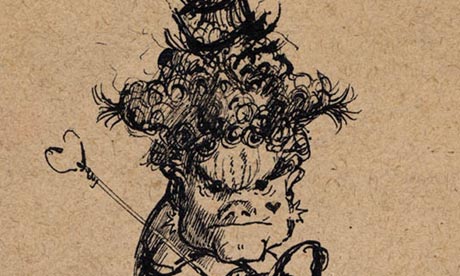
The dark turrets and chasms inside the mind of Mervyn Peake are familiar to readers of the Gormenghast trilogy and to fans of his surreal illustrations for Lewis Carroll's Alice's Adventures in Wonderland. But now previously unseen private letters, handed to the British Library, have revealed a crucial influence on the writer's troubled imagination: his travels through a devastated German landscape as a war correspondent at the end of the second world war.
The writer and draughtsman had been sent out on assignment for the Leader magazine in 1945 and the unsettling impact of the scenes he witnessed is clear from nine letters he sent home to his wife, Maeve Gilmore. Peake reported from a series of deserted and bombed-out cities, as well as from the former concentration camp Bergen-Belsen and from a war crimes trial, and he struggled to communicate the horror he experienced.
Attending the trial of Peter Back, a Nazi soldier accused of murdering an American airman, Peake writes to tell his wife of the German lawyer's efforts to explain how Back "had been warped" by his background. "Oh, Maeve, it was very tragic – its sadness is more upon me now than at the time…", the passage concludes.
Elsewhere in the bundle of private letters and rare illustrations handed over to the library this weekend is a description of the destruction he had seen: "Terrible as the bombing of London was, it is absolutely nothing – nothing compared with this unutterable desolation."
In a powerful letter to his wife, Peake paints a verbal picture of Cologne cathedral standing in stark contrast to the flattened city around it. "Bonn was nothing to Cologne from the point of view of destruction. It is incredible how the cathedral has remained, lifting itself high into the air so gloriously, while around it the city lies broken to pieces, and in the city I smelt for the first time in my life the sweet, pungent, musty smell of death. It is still in the air, thick, sweet, rotten and penetrating… But the cathedral arises like a dream – something quite new to me as an experience – a tall poem of stone with sudden, inspired flair of the lyric and yet with the staying power, mammoth qualities and abundance of the epic. Before it and beside me stood a German soldier, still in his war-worn, greeny-coloured uniform. His face betrayed nothing. Cologne lay about him like a shattered life – a memory torn out."
Rachel Foss, curator of modern literary manuscripts at the library, believes this private letter and others like it show how marked Peake was by the heavy responsibility of war reporting.
"He speaks of his intention 'of trying to portray the tragic side of things irrespective of whether it fits into the Leader or not'; and at another point of his decision to make records of what humanity suffered through war," Foss said.
The library acquired the archive for £410,000 with the support of donations from the independent charity The Art Fund and Friends of the British Library, Friends of the National Libraries and other individual donors. It arrived in 28 containers and includes 39 Gormenghast notebooks, as well as the complete set of original drawings for the 1954 edition of Carroll's Alice Through the Looking Glass and Alice's Adventures in Wonderland, and will be made available to students and researchers.
Dating from 1940 through to Peake's death in 1968, a number of the documents in the archive are unpublished material, such as correspondence with the writers Laurie Lee, Walter de la Mare and CS Lewis.
"Peake is one of the most eclectic of artists, with such a creative talent across a range of media," said Foss. "So to have all this research brought together under one roof will allow all the intricate connections and the interplay between his work to be studied properly for the first time."
The archive also features the unpublished draft of the sequel to the Gormenghast trilogy written by Peake's widow, which was discovered earlier this year by Peake's granddaughter in the attic of the family home. Gilmore based the new book, Titus Awakes, on a page-and-a-half of fragmented notes left by her husband after his death. It is to be published by Vintage Classics next year to mark the centenary of Peake's birth.
Next month, one of Peake's pen-and-ink illustrations for Alice will go on display in the Sir John Ritblat Gallery as part of the special exhibition, Curiouser and Curiouser: The Genius of Alice In Wonderland.
The complete set of illustrations for the book is to be exhibited at Sheffield University Library in June.

